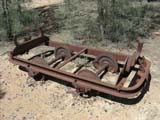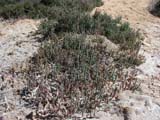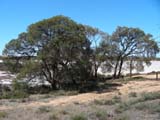A long time ago, the area that encompasses today's Murray-Sunset
National Park was covered by the sea.
As the planet dried out under the influence of an Ice Age, the
sea retreated but large areas of salt water remained trapped within
a layer of porous sand.
Then millions of tons of sand were stirred up by the wind and
dumped across the Mallee to build a vast field of sand dunes.
The underground water escaped into deep depressions between the
dunes and over thousands of years, the water has evaporated under
the hot, Mallee sun creating these lakes of pure salt.
Each winter the underground water rises and seeps out at the
edge of the lakes covering them with more salt water.
The underground water which seeps into the lakes is 800 times more
salty than sea water.
As summer begins, the water evaporates leaving salt crystals on
the surface.

|
The salt from Pink Lakes has been tested
as 99% pure.
This quality led to commercial salt harvesting from 1916
till 1979.
This one inch layer of fresh pure salt was mined between
November and April - the hottest part of the year.
As much as 500 tons of salt could be scooped from the lakes
in a day and during peak production from Lakes Crosbie, Becking
and Kenyon a harvest could yield 10'000 tons... at 10mgs
per day, that's enough salt for nearly 3 million people for
a year!
Salt has been used extensively for hundreds of years by
householders, farmers and industry.
Before refrigeration, salt was used to preserve meat and
is still used today for pickling.
Stock licks were manufactured for cattle and sheep.
Salt is used in the manufacture of pesticides, fungicides
and weedkillers and in the production of drugs and plastics.
Salt yields very pure caustic soda for soap products, chlorine
and hydrochloric acid used in the metal and food industries. |
The thirstiest job in the world
Imagine the constant taste of salt on your tongue ... and salt
sticking to he sweat on your skin.
Imagine the glare blinding your eyes and holes in your boots where
salt has worn them down.
Salt harvesting began at Pink Lakes in 1916 and was backbreaking
work in temperatures of over 40 degrees.
The work was done by hand.
Workers shovelled the salt into wheelbarrows and carted it across
planks to the shore.
Dry salt was broken up with picks and loaded into sacks.
The intensity of the Mallee sun left many itinerant workers from
the city, sick with the heat.
But local farmers who took advantage of the seasonal work seemed
to fare better.
Neville Kline described his father Jim ...
"He was as black as a dog's gut but never got the melanoma
- probably because he had an inch of leather for skin.
He was strong too.
Salt is heavy stuff and goes hard when it's damp.
They had to blow the stockpiles up with gelignite and crush it
to get it into bags."




Over the years, scarifiers and horse-drawn scrapers were used
to scrape the salt surface and were pulled by horses.
Salt is very abrasive and a set of horse shoes would last only
7 - 8 days.
Later, tractors and conveyors made some improvement to conditions
but salt harvesting would always be a tough job.
Beasts of Burden
Horses played an important role in salt harvesting for many years
dragging back-scrapers across the rakes and providing transportation
for the workers.
Both horse and bullock teams pulled wagons heavily loaded with
bagged salt to the Linga and Underbool Railway sidings ... a two
day journey.
Camel teams were introduced in 1922 and remained the fastest and
most reliable transport until 1935, taking only a day from Lake
Crosbie to the railway.


A tram line from Lake Becking to Linga was constructed in the
1920's but was plagued with difficulties.
The tram's engine caught fire on the first trip when salt bush
blew onto the track and ignited.
The track was frequently buried under drifting sands and the engine
had to be hauled over high ridges.
The line was abandoned within two years.
By the 1940's machines had replaced the horses and trucks became
the most efficient means of carting the salt.
"I can still hear the tingle of bells on the camels in my
ears ....
The idea was when turned loose on the reserves to water and feed
and rest they often wandered away.
One could hear the tingle and that would guide the driver to where
the camels were.
I think they used to make two trips to Linga station in three days.
A strong camel could carry four bags of salt roped to a pad on
the animal's back and a weak or pregnant camel, two bags, and salt
in bags weighed 12 bags to the ton.
Quite a sizeable load when a camel train could consist of from
12 to 20 beasts."
Frederick R. Butler, regular visitor
"The camels lived on the most natural grasses and vegetation
they could reach.
Most of the trees in the area were trimmed up to the height the
camels could reach, especially the Murray Pines. "
From F. R. Butler's notes.
History of the Pink Lakes
Doing time at the salt mines
1916 |
The outbreak of World War 1 in 1914 increased
the demand for salt.
Ebenezer Jones, the store keeper at Underbool, seized the
opportunity to begin commercial salt harvesting at Pink Lakes.
The hard work was done with picks and shovels.
|
1920 |
Scarifiers were introduced to break up the salt crust
and dragged out by horse-drawn scrapers.
|
1922 |
Afghan drivers and their teams of camels were brought
in from Broken Hill to cart salt to the railways at Linga
and Underbool. |
1924 |
The ill-fated tram line from Lake Becking to the Linga
railway line opened. |
1929 |
The Great Depression began and the salt mines attracted
itinerant workers from far and wide.
Many arrived on foot, others on pushbike or horseback. |
1935 |
The last of the camel teams departed having been replaced
by trucks.
Other improvement included salt crushers and washers and
a belt conveyor to load bags of salt onto the trucks. |
1943 |
An agreement was reached with Ebenezer Jones to supply
salt to the eastern states under National Security Regulations
during World War 2. |
1944 |
Italian internees were put to work at Pink Lakes and a
large camp was built at Lake Crosbie to house them. |
1947 |
Imperial Chemical Industries took over all the leases
of Pink Lakes and modern mechanisation was introduced.
Rubber-tyred tractors, graders, a specifically designed salt-harvesting
machine and mechanical loader simplified operations and speed
up the harvest. |
1968 |
Harvesting at Lake Becking ceased.
Mining continued at Lake Crosbie with the lease being granted
on a year by year basis. |
1979 |
Pink Lakes declared a state park and salt harvesting ended.
The nearby stock-pile and assortment of rusting equipment
was abandoned ... the only reminders of a once flourishing
local industry. |
1991 |
Pink Lakes incorporated into Murray Sunset National Park. |
Why are the Pink Lakes Flamingo Pink?
It was once thought that red Mallee dust coloured the lakes.
The land around them was reserved from sale to prevent them from
filling with windblown soil.
But the colour doesn't come from dust - it comes from a microscopic
animal-like plant, a single-celled alga called Dunaliella Salina.
The water in these lakes can be 800 times saltier than the sea.

|
One of the very few things that can live in these lakes
is this tiny alga which survives in many extremely salt-laden
lakes and ponds around the world such as the Dead Sea, Great
Salt Lake of Utah and Lake Eyre in South Australia.
This alga secretes the red pigment beta-carotene, a red-colouring
which occurs naturally in oranges, carrots, egg yolk and
lobsters and gives flamingos their colour.
Each cup-shaped oval to elongate cell (alga) possesses two
flagellae (antenna-like growths).
The red beta-carotene droplets protect the delicate creatures
from the light rays.
At times the Beta-carotene accounts for as much as 40% of
algae body weight.
Temperatures, salinity and light intensity affect the growth
of these tiny Dunaliella.
It flourishes under warm conditions, the optimum growth temperature
being around 26°C.
Reed pigment (beta-carotene) excreted from the Pink algae
combines with the water salt to produce a pink colour - best
seen in winter and spring following some rain - casting that
special pink glow across the lakes. |
Shrimp fee on this "algal soup" and then become food
for birds of the wetlands across other parts of the world.
Red-necked Avocats use their special curved beak to stir up small
shrimp and insects that feed on the pink algae.
What else survives under these conditions?

|
Grey Glasswort
This leafless plant stores water in fleshy, jointed stem
and has a tough, insulating "skin" to limit moisture
loss In hot weather.
As the plant absorbs water from the soil, salt is filtered
out and pushed to the end of the stems.
The tips eventually die and fall off.
|

|
Salt Paperbarks
Among the most salt-tolerant plants at Pink Lakes, the
Salt Paper-bark is the only tree.
An extensive root system filters water from the soil leaving
toxic salts behind.
Many layers of papery bark and tough, leathery leaves help
reduce moisture loss.
Salt Paperbark is another salt-tolerant indigenous plant
that offers food and shelter to Mallee plants and animals.
|
|









